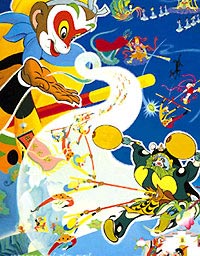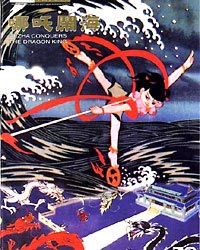| Tools: Save | Print | E-mail | Most Read |
| Chinese Animation: Splendid Past, Bitter Present |
| Adjust font size: |
The animated cartoon industry began in France in 1888, invented by Emile Reynaud and established in China in the 1950s. In addition to having a glorious age, Chinese animation now faces severe competition as the international industry is dominated by massive Japanese and US animation output. More and more Chinese children are fascinated by Transformers, Dragon Ball Garfield as well as Snoopy. So, what are the options for China's animation industry now?
History
Before 1949, animation did not make any headway in China. The Wan Brothers' Princess Iron Fan was representative of this period (taking three years, 237 artists and 350,000 yuan to make, Princess Iron Fan retold part of the popular Chinese folk-tale Pilgrimage to the West). In the period between the 1950s and the 1980s, China entered a golden era of animation. Many popular cartoon films were made, such as Scatterbrain and Crosspatch (1962) (video) and The Cowboy's Flute (1963) (video). Only in the decade between 1949 and 1959, the Shanghai Animation Film Studio produced nearly 100 films. Roughly estimated, since China's animation made its debut on the world movie circle, it has won 57 international awards and more than 200 local prizes. Its unique artistic style is known as the "Chinese School" worldwide. Let's see some typical examples of China's animation over its glorious age. Little Tadpole Looking for Mummy (1960)
The film, directed by Tang Cheng and Te Wei, won best animation movie in the first Chinese Hundred Flowers Awards. Established in 1962 by the Popular Movies magazine, the awards, an annual event, are decided by the number of votes submitted by the general public. Uproar in Heaven (1961, 1964)
Uproar in Heaven won the best animation film in the second Hundred Flower Awards and is regarded as one of the most successful animations for it creates a cartoon hero Sun Wukong (monkey king) which has become a household word in China. Nezha Conquers the Dragon King (1979)
Nezha Conquers the Dragon King, directed by Wang Shuchen, Yan Dingxian and Xu Jingda is the first wide-screen animated feature produced in China, wining the best animation film in the third Hundred Flower Awards in 1980. The production of animation was suspended for almost 10 years during the Cultural Revolution. So Nezha's return is of far-reaching importance to China's animation as well as China's cultural circle. Three Monks (1980)
Three Monks, directed by late cartoonist A Da, won the best animation film in the first Golden Rooster Awards. Established in 1981 by the China Film Association, the award is so named because 1981, according to Chinese lunar calendar, was the year of rooster. The yearly awards are decided by a special committee composed of film experts. Three Monks also won a Silver Bear for Short Film at the 32nd Berlin Film Festival in 1982. Calabash Brothers (1987)
As one of the most popular animated cartoon series in China, Calabash Brothers, directed by Hu Jinqing, Ge Guiyun and Zhou Keqin, is a typical Chinese paper-cut animation, winning third class award at the Cairo International Children's Film Festival in Egypt.
Present
Then what are the main obstacles for the development of Chinese animation today? Following are some key reasons, according to the insiders: First, lack of individual characteristics both in story and characters. Actually, animation in every country has its own characteristic. For instance, Iron Boy from Japan, Blue Fairy from France, and The Mole from the Czech Republic and Teenage Mutant Ninja Turtles from the United States obviously have different styles and characters. In a recent survey, 1,753 respondents aged 10 to 35 ranked eight Japanese animation productions among the 10 most popular animated cartoons. The other two were Tom and Jerry and Mickey Mouse and Donald Duck from the United States. Today if you ask the average primary school student in China about his most favorite cartoon hero, you'd likely hear a large of variety, but few of them would be created locally. Second, dryness of content and persistent education. Chinese people usually attach importance to education, especially to children's education. They are in the long habit of saying: you should do A and not B. As a result of such blunt demands, all demon characters in Chinese movies inevitably have the unambiguous look of "bad people". While Chinese children are just not as stupid as they can be made out to be, the kids gradually notice that the simple but very "meaningful" cartoons have insulted their intelligence, and they immediately throw them away without mercy, no matter how "meaningful" it is. Wouldn't it be better to let children differentiate between good and evil, and experience life and understanding by themselves? "Foreign productions are far more original and entertaining," said Sun Lijun, dean of the Animation School of the Beijing Film Academy. "They focus on adolescent exuberance, and glorification of fine dreams and the imagination of the young, whereas ours tend to be too educational and political." Furthermore, we should get rid of the long-standing mistaken idea that the cartoon is the preserve of children. Animation belongs to everyone, not only just for the kids, but for men and women, young and old. Each person can find some happiness in seeing a wonderful cartoon movie as well as being enlightened from an intriguing plot. Third, shortage of funds and animators. Compared to the west, professional animators in China earn only 100 yuan ($12) per frame. According to Professor Huang Huilin of Beijing Normal University, China's animated cartoon industry currently has as many as 150,000 job vacancies. Shanghai Animation Film Studio now has 10-plus animation directors. Surprisingly, the average age of them is over 50! A deeper crisis in China's animation industry is hidden behind the wholehearted spirits of these senior directors. We are now badly in need of animation directors who are familiar with modern life and culture, sharp-sighted in the international market, humorous and originally witty, for the most effective way to revive and secure the survival of Chinese animation is to train professional animators.
(China.org.cn by Li Xiao, January 18, 2004) (video source: Shanghai Animation Film Studio) |
| Tools: Save | Print | E-mail | Most Read |
 |
| Related Stories |
|
 |
|
Product Directory China Search |
Country Search Hot Buys |





